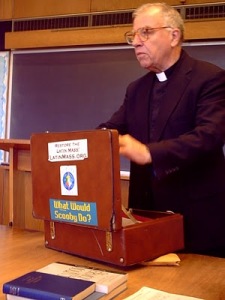Such a view of holiness, resting at it does on the Word and sacrament, placing primary emphasis upon objective factors and leaving the subjective spiritual signs on the periphery, can of course be looked upon as saltless and secular. But Luther’s sensitive and often anxious and tormented heart led him to view man’s relationship to God always from God’s side (coram Deo), with the result that man always found himself in the position of the judged. In his afflictions (Anfechtungen) one must place his confidence in the objective foundation of salvation, the Word and sacraments. Faith then becomes striving faith. Unless the knowledge of God’s judgment remains vital, this way of sanctification can easily lead into superficiality and worldliness. But in the final analysis the alternative is no better. Where the point of departure is man, his piety and the marks of faith, the state of condemnation before God becomes secondary. Man’s primary existence is then before men (coram hominibus) and his spirituality serves to exalt him above others. This has always and in all things been man’s goal. Success in the achievement of this goal is not to be confused with sanctification.
In Luther’s conception of holiness the issue is always faith, not works. To the very end man is in himself a sinner and under God’s judgment. The severe criticism to which Luther’s struggling faith was subjected in his own time has continued in later times. He has been accused of stopping at a halfway point. The fanatics and the Anabaptists accepted the Reformation because the Catholic church had not done full justice to faith; but they wanted to reform the Reformation because it had not permitted works to come to their own. In Pietism this new reformation broke out. but it was forgotten that Luther saw a more effective realization of holiness in the continuing work of the Holy Spirit than in all the emphasis upon works.
The difference between Luther and Pietism is greater than is usually thought. Luther’s “new” man is not the same as Pietism’s converted man. The latter is a psychologically new individual, awakened into life by conversion, whose goal is to reach full maturity in holiness. The “new” for Pietism is a psychological reality in man. The struggle for holiness takes place between two levels of life, the lower life of nature and the higher life of the spirit. In Luther’s view the situation is quite different. The “new” in the believer is for Luther not a higher nature or a new individual capable of sensible expression. The “new” in the believer is Christ’s alien righteousness. The total old self, our old state of being – conversion and holiness included – is solely our own and therefore flesh. Insofar as our works are concerned, it cannot be anything else. The struggle for holiness is carried on in faith and involves Christ, who is really present, and our total self. Included in this self are the higher as well as the lower capacities of the soul and impulses of the will. No level of our personality is so high that it would not in the final analysis be dominated by self. In sanctification it is precisely this self that is striving against God (homo incurvatus in se) and must be beaten down. Luther always viewed man from the total point of view; to him man is an indivisible entity. In the view of Pietism man is a divided being and the struggle between the old man and the new is a struggle between two psychological levels within man.
Because Luther does not see holiness primarily as a matter of works he has been charged, both in his own day and later, with passivity. Such a charge, however, is both shallow and unfounded. It is shallow because it is informed by a desire to make holiness perceptible to the senses, and a lack of confidence in God’s hidden work in the believer’s heart. It is unfounded because Luther’s purpose was to direct men into the struggle for holiness, the struggle of faith against the devil, sin, and the flesh. This warfare can be called daily repentance. Though the primary focus may be not on works but on the conscience awakened by God, more is involved than merely Christ and conscience. Daily repentance comes to expression – and inevitably so – as works, though not as works of law but as works of the new man, as obedience of faith, as love.
Lennart Pinomaa, “Faith Victorious: An Introduction to Luther’s Theology”, pages 71-73
